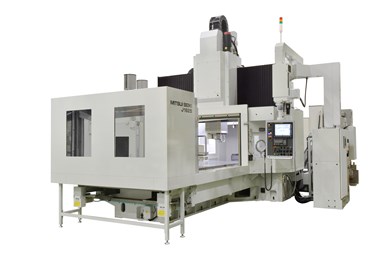Mitsui Seiki USA Launches New Line of Jig Borers
The J12/J/16 jig borer series feature a durable structure that provides table lateral movement accuracy of 2.5 µm or better.
Mitsui Seiki USA, a leading builders of jig borers, introduces its newest line, the J12/J/16 jig borer series, which combines large capacity and high precision for machining workpieces such as molds and castings. The machines offer Y-axis stroke of either 1,250 mm or 1,600 mm, with standard table sizes of 2,400 mm × 1,250 mm or 2,900 mm × 1,600 mm.
The machines’ durable structures are said to provide table lateral movement accuracy of 2.5 µm or better. The Z-axis guide system is restrained on four sides to maximize rigidity and reliability, and dual ball screws ensure stable feed motion.
For precision holemaking applications, XY interpolation enables the J12/J16 machines to carry out high-precision contouring by utilizing an end mill instead of a boring tool, eliminating the need to manually adjust a boring tool to accurately finish the hole diameter avoiding bottlenecks. Pitch accuracy is within 5 µm even for large-pitch holes.
The machines feature a 12,000 rpm 50 taper spindle and automatic toolchange capacity of 60 tools. Additional options such as quill spindle, increased work capacity and automation features are available.
“Jig borers typically last 25 to 30 years,” Mitsui Seiki USA’s COO Bill Malanche, says. “Machines in Mitsui Seiki’s J12/J/16 jig borer series are engineered to process a large range of part sizes with unceasing repeatability. They provide the durability, accuracy and flexibility required in today’s highly competitive manufacturing environment.”
Related Content
-
Volumetric Accuracy Is Key to Machining James Webb Telescope
To meet the extreme tolerance of the telescope’s beryllium mirrors, the manufacturer had to rely on stable horizontal machining centers with a high degree of consistency volumetric accuracy.
-
Understanding Swiss-Type Machining
Once seen as a specialty machine tool, the CNC Swiss-type is increasingly being used in shops that are full of more conventional CNC machines. For the newcomer to Swiss-type machining, here is what the learning curve is like.
-
A New Milling 101: Milling Forces and Formulas
The forces involved in the milling process can be quantified, thus allowing mathematical tools to predict and control these forces. Formulas for calculating these forces accurately make it possible to optimize the quality of milling operations.

















